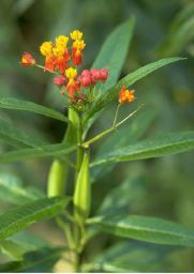

Common Names: Blood-flower,
Tropical Milkweed
Genus: Asclepias
Species: curassavica
Parts Used: roots and flowers

This herb produces red and yellow blossoms in the spring which are less than an inch across. The 5 outside petals, or corolla, are red and curve down. The 5 inside petals are hooded and yellow or orange. They grow in a cluster at the top of woody stems
The milkweed has a white, poisonous sap from which it gets its name, and can grow to be 2 to 3 1/2 feet. It has big leaves that can grow to be 9 inches -1 foot long. The seeds, which grow in a pod, have a silky tuft of hair which allows them to be blown by the wind like little parachutes.
It attracts bees, butterflies, and hummingbirds. Monarch butterflies particularly like it , just like butterfly weed, which is in the same family. Milkweed is the flower of choice for Monarchs in North America.
It was an all-purpose remedy for Native Americans. The Omaha Indians used milkweed root as a salve for wounds. Navaho women made a tea from it to prevent pregnancy, but scientists do not believe that it helped. However, the weed's roots do posses properties that heal wounds.
Milkweed is a native plant of the South American grasslands. It can be found in southern Canada, and the central United States, but its favorite place to grow is South America.
by Becky W. 2000.
Bibliography:
(1999). Island Co-housing Plant Manual, Martha's Vineyard: Indigo Farm.
(1985). Grassland and Tundra, Alexandria, Virginia: Time-Life Books Inc.
Cronquist, A. & Hitchcock, C. (1973). Flora of the Pacific Northwest, Seattle and London: University of Washington Press.
"Milkweed" http://www.desertUSA.com (6-6-00)